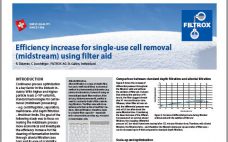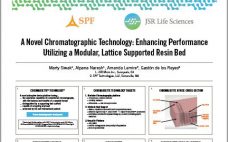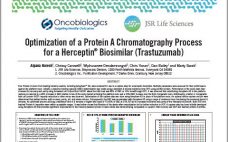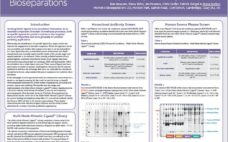Current trends in the bioprocessing industry are driving mAb and plasma producers to formulate at higher protein concentrations. As a result, formulating using tangential flow filtration (TFF) may be limited in reaching these concentrations due to high pressures caused by highly viscous feed streams. Filtration devices used during processing have to be optimized in order to handle both high viscosity and pressures while maintaining high flux and excellent product recovery. In this study, a family of filtration devices was evaluated…
Posters
Efficiency Increase for Single-Use Cell Removal (Midstream) Using Filter Aid
Continuous process optimization is a key factor in the biotech in-dustry. With higher and higher particle loads (>108 cells/ml), standard technologies for cell removal (midstream processing) – e.g. centrifugation, separation, membrane- and depth filtration – find their limits. The goal of the following study was to focus on making the midstream process more economical and investigate the efficiency increase for the cleaning of fermentation broths through alluvial filtration (see box) and its ease of scalability. This technology leads to a…
A Systematic Development Approach to Optimize and Control Biopharmaceutical Product Quality
The complexity of recombinant protein manufacturing processes, including expression systems, cell culture process conditions, and choice of media and feeds, present signifi-cant challenges to achieve desired product quality of bio-pharmaceuticals. To address these challenges, Fujifilm Diosynth Biotechnologies (FDB) has developed a unique systematic approach of combining “Media Toolbox” methodology, key chemical components, and cell culture bioprocess “know-how” to optimize and control manufacturing condi-tions that promote the desired product quality profiles of recombinant proteins. Case studies are presented to highlight the…
A Novel Chromatographic Technology: Enhancing Performance Utilizing a Modular, Lattice Supported Resin Bed
This poster highlights the Chromacassette® Technology: First practical modular chromatography platform. Supported-bed enables packing of any resin bead. Constant bed permeability, independent of resin compressibility even at V > 1000 cm/hr. Truly linear scalable. Eliminates packing methods and equipment. New operating domains and resin design are now possible for both bind and elute and flow-through. Hyper-Productive™ process enabling for single-use chromatography. PD devices will be available early 2018.
Optimization of a Protein A Chromatography Process for a Herceptin® Biosimilar (Trastuzumab)
Four Protein A resins from leading industry vendors, including Amsphere™ A3, were screened for use in a capture step for a Herceptin biosimilar. Multiple parameters were assessed for their performance against the platform resin. Initially, a dynamic binding capacity (DBC) determination was made using a standard 4-minute residence time (RT) using purified protein. Performance of the resins were then screened for recovery and purity using harvested cell culture fluid (HCCF) where the MAb load was 80% of DBC at 10%…
Comparative Study of Commercially Available Protein A Chromatography Resins and Amsphere™ A3
Host cell proteins (HCPs) in biopharmaceuticals must be controlled in the downstream process (DSP) of antibody production, since it has critical influence on product quality. Generally, the majority of HCPs in harvested cell culture fluid are removed during the affinity step using Protein A chromatography resin, and the remaining HCPs are remove in the polishing step by a combination of ion-exchange chromatography, hydrophobic interaction chromatography, etc. Thus, identification of remaining HCPs after Protein A affinity chromatography process can work as…
Multi-Mode Mimetic Ligand™ Library – A Rapid Screening Toolbox for Target Protein Purification
Small synthetic ligands have established themselves as an essential component of modern downstream processes, both as specific ligands for product capture or the targeted removal of impurities and more generally for product polishing applications. Historically, the identification of a specific ligand for a target protein has required the engagement of specialist companies. Whilst this approach can be very successful, such studies often require some time to set-up and perform (i.e. from ligand discovery, to adsorbent/process development and finally manufacture) and…
Targeting Desired N-Linked Glycosylation Profiles Through The Use Of Glycosylation Enhancing Feeds And High Throughput And High Resolution N-Glycan Analysis By Multi Capillary Electrophoresis
Glycosylation is a key product quality attribute for many biotherapeutic proteins expressed in CHO cells. N-linked glycans may display macro- and micro-heterogeneity; the degree of this variation can depend on several factors, including cell line, media/feeds, and process. As a consequence, it has often been challenging to achieve and maintain preferred glycosylation profiles from cell culture development through bioreactor scale-up. In order to address these challenges, we have developed a new feed technology in conjunction with a unique fed-batch process…
High Density Culture Strategies For Improved Scalability With Single-Use Systems
Improvements in single-use systems have allowed implementing high-density cultures in standard work flows. The current study shows integration of the Thermo Scientific™ HyPerforma™ Single-Use Bioreactor (S.U.B.) and the XCell™ ATF6 Single-Use (SU) System to achieve high-density cultures. Current results are compared against similar cultures using a stainless steel ATF6 system. The S.U.B. was able to support high-density cultures (>40E06 cells/mL) without modification to standard single-use components and maintained proper operating parameters. Scale-up criteria for both S.U.B. and ATF are provided…
Rapid and Simple Sample Preparation for High Throughput, High Resolution and Sensitive Glycan Analysis by Capillary Electrophoresis
Here, we report the simple and rapid GlycanAssure™ workflow that combines high throughput and high resolution glycan analysis of 96 samples in 7-9 hours using Applied Biosystems™ 3500xL 24-capillary electrophoresis system. The process eliminates vacuum drying and highly toxic cyanoborohydride in the labeling reaction. Use of Dynabeads™ magnetic beads for glycan purification post deglycosylation and removal of free dyes after labeling streamlines the process for automation. Capillary electrophoresis can detect less than 0.2 fmol/ÎĽL of labeled glycans. Two proprietary fluorescent…










